HISTORYof KABUKI
During the period of the Ashikaga Shogunate (1338-1573), Kyoto was the centre of luxury and effeminate culture among the wealthy, and of increasingly licentious revelry among high and low alike. The first half of this era, known as the Muromachi Period (1338-1443), was characterized by an influx of Chinese influence, an increase of education among the priesthood, and of such gentle arts as Cha-no-yu (tea ceremony), Ko-awase (incense judging), and Ikebana (flower arrangement), among the leisured. Noh, also, during this period, was brought to its perfection and exercised a refining influence over the military class in particular. None of these apparently noble arts, however, was able to check the social evils which grew up, especially during the later years of that Shogunate (1444-1573), in part because of the strict isolation of the sexes demanded by Buddhist ethics and Buddhism's failure to bring matters of sex under the ennobling sanctions of religion.
While the upper classes found their recognized amusements in cultured ways on the one hand, and their secret delights in the practices of exclusively male society on the other, the great mass of the people were entertaining themselves upon the dry river-beds or in vacant lots within the city with popular Dengaku, Sarugaku, and other sports of rude promiscuity, wherein not infrequently men of rank also found relaxation.
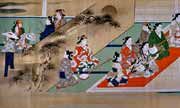
Into the arena of popular sport, somewhere about the end of the sixteenth century, whenEngland's Shakespeare was in his prime, came a dancing-girl, known to us as Okuni of Izumo. She seems to have been the daughter of an iron-worker, and a skilled Maiko in the service of the shrine at Izumo, which, though Shinto, was at the time in the charge of a Buddhist priest. Her presence in Kyoto is traditionally explained by the supposition that she may have been on a tour seeking contributions for the shrine. However that may have been, she met with such welcome inKyoto that she remained, to be identified with a new dramatic movement rising from the midst of the common people.
Okuni's Kagura seems to have been a form of Buddhist nembutsu, a dance of worship in praise of Amida; but her reception on the Kyoto river-beds may well have been due more to her physical beauty and grace of movement than to any appeal in the interests of religion. Here, in any case, about 1596, she was seen by Sanzaburo, who fromNagoya had been sent by his family to be trained for the priesthood in the Kennin Temple, one of the then famous Five Temples, inKyoto.
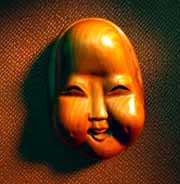
This youth of a military family had no fondness for the austerities of religion, but led a life of social freedom, and was popularly known for excellence in social arts, including the Kyogen of Noh. He was attracted by Okuni, but found her graceful dancing too restrained to satisfy his taste. Apparently without difficulty, he influenced her to greater abandon, and taught her to dance the popular songs of the day to music of his own composition. This was Kabuki, a slang designation of the time later to be dignified by the use of written characters signifying the art of song and dance.
Two trained players thus broke from the bonds of dramatic custom, and, seizing upon material nearest to the popular mind, made another beginning which is now to be traced through developing forms unto the modern legitimate drama of Japan.
A few of Okuni's Kugara are extent, and the following Tenshi Wago Mae (Dance of Heaven and Earth Affinity) is significant in its blending of Buddhist repression with nature myths from Shinto, capable of most spiritual as well as most carnal interpretation. Interpreted spiritually, we cannot but be impressed with the beauty of its conception; but in an historic study we need to remind ourselves that the carnal interpretation was the most apparent in old Japan, where, under Buddhist influence, all love meant passion of illusion.
HEAVEN AND EARTH AFFINITYWith great endeavor
Expending from the heart,
No god soever
The work that I have finished
Can fail to mark as worthy.
The god of power
Enshrines within my being:
My very breathings,
That come and go, are shrines,
The outer and the inner.
With sounds of music
Ringing, I splash the water
So clear and shining,
Over my shoulders pouring,
Over my shoulders pouring.
Ocean eternal!
Drops from the creative spear
Had there been none,
I should not have been born--
Born to a life of illusion.
If from the spear-point
Dew-drops in falling had not
Hardened to mountains,
Naught would there be like to love,
Vanity all and illusion.
Like to the falling
Drops from the spear-point divine,
Newly created,
Man's life becomes but a dew,
Dew that a breath drieth up.
Gone are the worries,
Troubles of olden days,
All, all forgotten;
While in their place flows great joy,
Joy that o'erwhelms with its bounty.
Kabuki--the Art of Song and Dance--was first called Onna Kabuki, Okuni being a woman (onna); although, as her religious chants gave place to popular folk-songs, she wore the garments of men and acted the part of one who frequented tea-houses and sported with their inmates. She soon gathered about her a group of players, women, children, and men in the garb of women, Sanzaburo himself presenting Kyogen as interludes.
Titles only remain of songs which might illustrate this transitional period more fully than do the Kagura. One was the Crow Dance, of which we know nothing beyond the fact that wings were worn in its presentation. Another was the Dance of Married Intimacy, also called the Young Girl Dance; and this was probably of a nature that prevented its preservation in writing.
Popular Sarugaku, left behind as an undeveloped remnant by Noh, formed the basis of the comic interludes presented by Sanzaburo; and in illustration of these may be mentioned Saruwaka Daimyo and Hanagasa Odori, the latter being played by lads of twelve or thirteen years of age, who, according to old pictures, wore wide-brimmed hats of straw decorated with artificial cherry-blossoms and bound under the chin with red ribbons.
In an old book of Kabuki pictures there are fragments of song which illustrate the better type of those which followed the nembutsu. In one instance an actor, possibly Sanzaburo, tells Okuni that he will sing a Joruri-like song, evidently meaning a sentimental love-song as unlike the nembutsu and the battle chants of the Monogatari.
Our love is troubled,
As the moon by clouds,
Or flowers by winds that blow.
To win my way of love is hard
As passing mountain pathways for mounted horsemen.
In some distant village,
Beyond the mountains,
Far from the world of prying folk,
In secret I would love.
As rhythm to all music,
So is my love:
At eve I play the entertaining flute,
Atmidnight sing;
Upon the flageolet at dawn
I voice my love.
Whene'er I waking leave thy side,
I long again for thee;
And when I see the blossoms droop
Beneath the rains of spring,
I would not have you fade like them--
A maid unwed.
By 1603-1604 Okuni had reached the height of her popularity, and had established stages in various parts of the city. Her plays were addressed primarily to the common people; but she soon attracted the attention of the nobility, and was invited to play at the residence of the Shogun. There is a record of at least one invitation to play before the Imperial Court in 1603-1604.
Such success led to imitation, and the number of Kabuki playhouses multiplied; but, in spite of occasional signs of aristocratic favor, Kabuki remained essentially an entertainment of the common people--in reality a protest against social as well as dramatic conventions. Those who devoted themselves to its interests were men without honourable employment and women from the prostitute quarters. Gross immorality and unbridled licentiousness made it a social danger; and as early as 1608 official order confined it to the outskirts of the cities. In 1629 Onna Kabuki was strictly prohibited, avowedly because of its immoral influence, possibly because of its being also a hotbed of dangerous thought and popular freedom.
The doom of Onna Kabuki seems to have been foreseen by some, for in 1617 Dansuke, who had been conducting a company of women, founded the first company composed of men-players only. Men, especially young men, had played in Onna Kabuki; and it probably was not difficult to build up a company from these and from men about town, as the downfall of the Ashikaga Shogunate had left many of its natural supporters without employment. As women were forbidden the stage, young men held a monopoly of the female parts; and for this reason the new companies and their plays were known as Wakashu Kabuki.
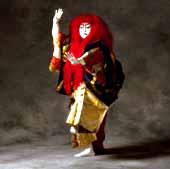
To compensate for the absence of women upon the stage, greater attention was given to matters of costume and scenery; and the plays appear to have retained their full measure of popular favour. The object of official prohibition, in so far as it had to do with public morality, however, was not attained, for grosser forms of prostitution became increasingly prevalent. Official disapproval of Kabuki, together with the generally recognized immorality of the Kabuki stage, was probably a contributing cause of the renewed popularity accorded Joruri, which was at the time enriching its presentation with the use of dolls in Ayatsuri. Here also may be found some explanation of the fact that Chikamatsu, who had begun to write for Kabuki, turned his talent exclusively to the needs of the Ayatsuri stage, which owes much of its abiding importance to the genius of his compositions.
In 1644, when Wakashu Kabuki was most popular, official prohibition was renewed to stop the employment and training of young boys, which, it was charged, was undermining the morals of the warrior class; and in 1652 this second type of Kabuki was banned.
Profiting not a little from the example and success of the Ayatsuri stage, Kabuki refused to be destroyed. In spite of restrictions--perhaps in part because of them--it had made for itself a place in the social life of the people which demanded satisfaction. Older men continued the Kabuki tradition of freedom; and there developed the Yara (adult male) Kabuki, which enriched its presentations with music and the inclusion of better dramatic material to compensate for the relative absence of debasing elements.
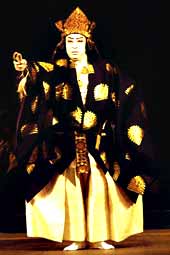
Maintaining its dramatic freedom, Kabuki developed its art eclectically from Kagura, Noh, Kyogen, and Ayatsuri, borrowing, particularly from the latter, material which it worked over into form more suited for presentation by living actors. Upon much of this material, however, the stamp of Ayatsuri is indelibly fixed, as may be noted in the retention of takemoto, or reader, for certain passages which seem to us quite as well adapted for the dramatic actor. In the material thus brought into use upon the Kabuki stage four distinct classes may be discerned. There are Historical Plays (Jidai Mono), such as are found in Joruri and Ayatsuri, in which historic characters and a thread of fact serve to sustain a display of bravery and devotion vicariously satisfying and of inspirational value; Plays of Common Life (Sewa Mono), foreshadowed in Genzai Mono Noh; Plays of Unrestrained Action (Aragoto), closely associated with the great Ichikawa family and its style, which was in every particular a skillful use of exaggeration; and Pantomimic Plays (Shosagoto), which owed more to early dance traditions in Kagura and Noh than to any literary antecedent.
In all earlier forms of the Japanese drama the liturgic requirement, on the one hand, or the will of the author, upon the other, governed the stage. Now, for the first time, the actor is seen taking a position of control; and this in a measure accounts for the slight attention given to originality in the material of Kabuki. Not composition but presentation was the problem of the Kabuki stage. With the development of the Yara Kabuki actors began, more generally than before, to train themselves for specific parts. In the earlier Kabuki men had often played the part of women; but now, when it had become necessary that they should do so upon all occasions, a professional class of womenfolk (onnagata) grew into prominence. Attention to technique and pride in accomplishment secured marked results; and individual actors established family claims to certain rôles. Dramatic skill of a high order took the place of personal grace and of sex appeal upon the Kabuki stage. Books by the series have been written concerning the dynasties of various dramatic families which from the time of the Genroku Age contributed to the development of Kabuki; and Sakata-Tojuro ofKyoto and Ichikawa-Danjuro ofTokyo are still names with which to conjure.
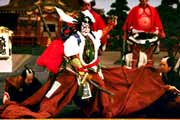
Together with its relative freedom Kabuki developed its own conventions adapted from earlier forms, and applicable to manner of staging and action rather than to nature of material. The Flower-way (Hanamichi), along which the actor approaches the stage through the midst of the theatre audience, may be taken as an example. It is merely an adaptation of the conventional approach to the Noh stage; but it is significant in that it connotes a much closer contact between audience and actor. Its principal advantages are self-evident, and it marks the Kabuki for what it is--a play of the people for the people.
With the new emphasis upon actor rather than author there came into being a new type of criticism; and 1656 is mentioned by Ibara as the probable date of the first published article of dramatic criticism. From mere expressions of personal opinion these grew into studied declarations of judgment, and form a body of literature known as Chronicles of Fame (Hyobanki), which should be studied intensively for a more detailed account of the People's Theatre.
Following the Genroku Period (1688-1703), for a century and a half the Japanese drama shows no development. The time was a time of general quiescence, of rest, without inspiration from the past or hope for the future; and it was not until the middle of the nineteenth century, when a member of the famous Ichikawa family brought Sewa Mono again into prominence, that its vitality became evident.
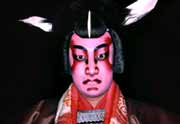
The history of Kabuki is worthy of more careful investigation, for in its development are found elements of all preceding forms of the Japanese drama, and, in spite of serious abuses, those essentials of popular co-operation without which no truly national drama can evolve. Kagura, with its intimate social contacts, became stereotyped in the liturgy of Shinto; Noh and Kyogen, with their great dramatic possibilities, were refined to death; Kabuki alone, without patronage and amid vulgarity, wrought out a form of drama so generally satisfactory that one can but wonder what might have been its achievement had it received encouragement in freedom and guidance in art. The dramatic instinct lives in the Japanese people; and there is reason to hope for its future expression if it can conserve the riches of its past achievements and avoid the blight of modern emphasis upon things which are seen and are therefore temporal.